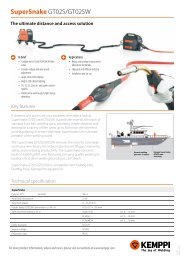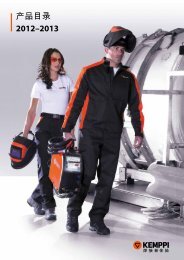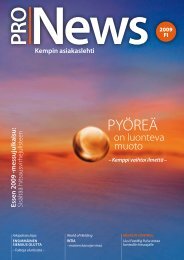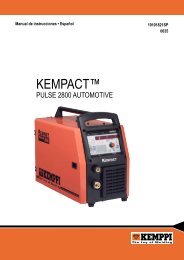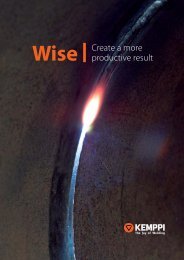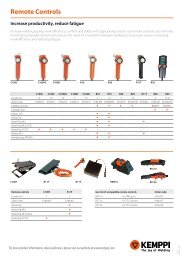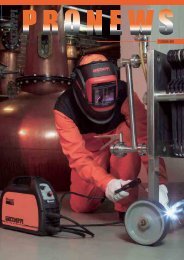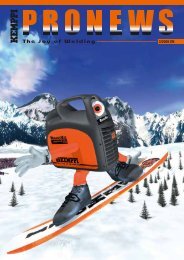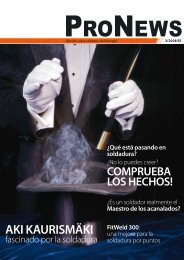You also want an ePaper? Increase the reach of your titles
YUMPU automatically turns print PDFs into web optimized ePapers that Google loves.
Program<br />
Fe -group<br />
Wire (mm) Material Shielding gas Backing<br />
903 1 Fe Ar+18%-25% CO2 904 1,2 Fe Ar+18%-25% CO2 913<br />
Ss -group<br />
1 Fe CO2 923 1 SS-316 Ar+2%CO2 Ar<br />
924 1,2 SS-316 Ar+2%CO2 Ar<br />
933 1 SS-316 Ar+30%He+1%02 Ar<br />
934 1,2 SS-316 Ar+30%He+1%02 Ar<br />
Figure 7.<br />
Synergic curves included in a standard delivery.<br />
6<br />
<strong>Kemppi</strong> ProNews 2 • 2006<br />
Figure 8.<br />
T-joint, 1/2V-groove 45 o , root run welded in PG<br />
position and fill-up run in PF position, air gap 5 - 6<br />
mm, welding current 146A, voltage 16V, speed 100<br />
mm/min, energy E=1.4 kJ/mm and heat input Q=1.1<br />
kJ/mm<br />
Figure 9.<br />
Butt joint, V-groove 60 o , root run welded in PG<br />
position and fill-up run in PF position, air gap 3 - 4<br />
mm, welding current 130A, voltage 16V, speed 138<br />
mm/min, energy E=0.9 kJ/mm and heat input Q=0.72<br />
kJ/mm<br />
Figure 10.<br />
Butt joint, V-groove 60 o , root run welded in PE<br />
position and fill-up run in PE position, air gap 3 - 4<br />
mm, welding current 110A, voltage 14V, speed 76<br />
mm/min, energy E=1.3 kJ/mm and heat input Q=1.0<br />
kJ/mm<br />
Various techniques can be used when welding<br />
the root pass. The <strong>FastROOT</strong> process allows for welding<br />
the pipe in the downward direction from 12 o’clock<br />
to 6 o’clock or from 12 o’clock to 9 o’clock, while a regular<br />
short-arc process allows for upward welding from 6<br />
o’clock to 9 o’clock (see Figure 4). In the right-hand side<br />
of the fi gure, the <strong>FastROOT</strong> process is used for welding<br />
from 12 o’clock to 6 o’clock by moving the torch at<br />
a 10–15-degree angle. In the left-hand side of the fi gure,<br />
the <strong>FastROOT</strong> process is used for welding from 12<br />
o’clock to 9 o’clock and a normal short arc is used for<br />
welding from 6 o’clock to 9 o’clock. The welding machine<br />
also allows for welding so that the pipe is rotating<br />
and the torch remains, for example, at 2 o’clock.<br />
The most important objective in the motion technique is<br />
to maintain the arc on top of the weld pool and not on its<br />
side (see Figure 6). There is suffi cient power in the arc<br />
to make the fi ller wire push through the weld pool at the<br />
sides, causing root-side spatter. The arc must be kept on<br />
top of the weld pool during the oscillation. The welder<br />
should not wait at the sides; instead, the direction of motion<br />
must be changed immediately after the oscillation<br />
ends. The oscillation is faster than in regular vertical up<br />
short-arc welding. The <strong>FastROOT</strong> process allows for<br />
welding without the oscillation. This increases the travel<br />
speed but the weld run surface will not have as smooth a<br />
shape as with the oscillation technique.<br />
Applications of the process<br />
The <strong>FastROOT</strong> process has been developed particularly<br />
for root pass welding but can also be used for thin<br />
sheet welding. The most commonly welded materials<br />
are structural and stainless steels. Figure 7 lists the<br />
synergic curves included in a standard FastMig Synergic<br />
welding machine delivery. In addition to these, it<br />
is possible to create customer-specifi c curves designed<br />
for various production needs in the machines. The fi rst<br />
customer-specifi c curves have been created for ferritic<br />
stainless steel EN 10088 1.4539 -904 L and EN 10088<br />
1.4464 – 22%Cr duplex steel. In addition to these, there<br />
are stainless steel welding curves designed for various<br />
shielding gas mixtures.<br />
The fi rst users of the <strong>FastROOT</strong> process include Norwegian<br />
companies in the offshore industry. The customers<br />
have characterised the process as easy to use and<br />
adjust. The spatter-free results in welding pipe steel has<br />
also received praise. The process is currently in daily use<br />
in the Ormen Lange project in Norway. It is the secondlargest<br />
marine gas fi eld project with the greatest demand<br />
for pipelines in the world.<br />
Offshore customers had welding tests carried out on<br />
the process using different types of joints and welding<br />
parameters. The test results and welding parameters are<br />
presented in fi gures 8-10.



